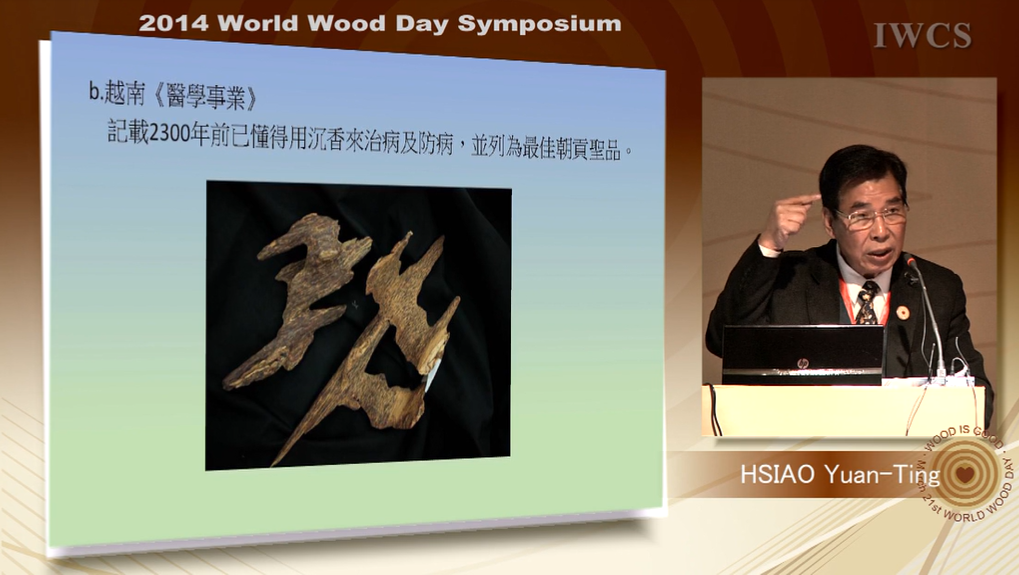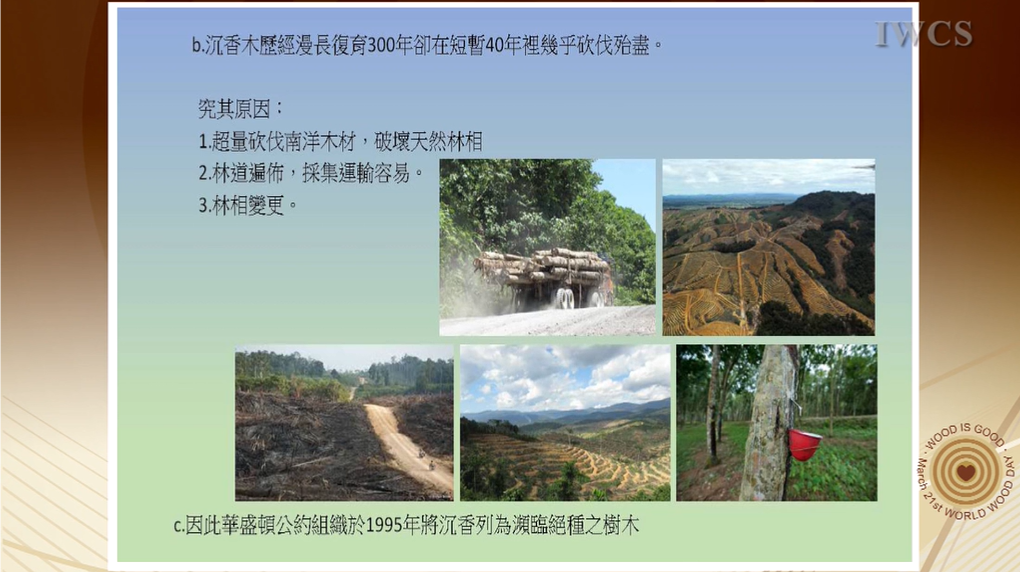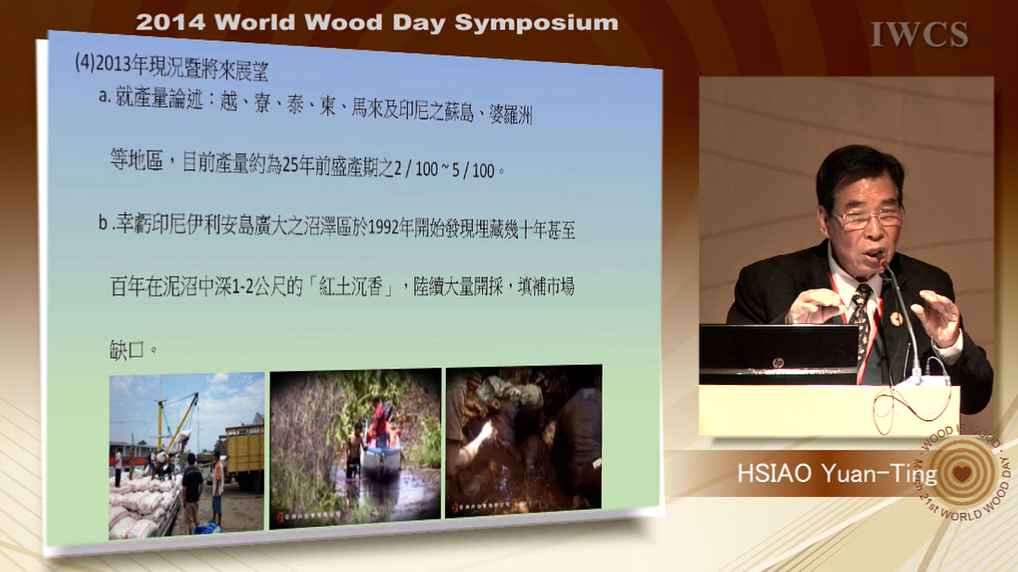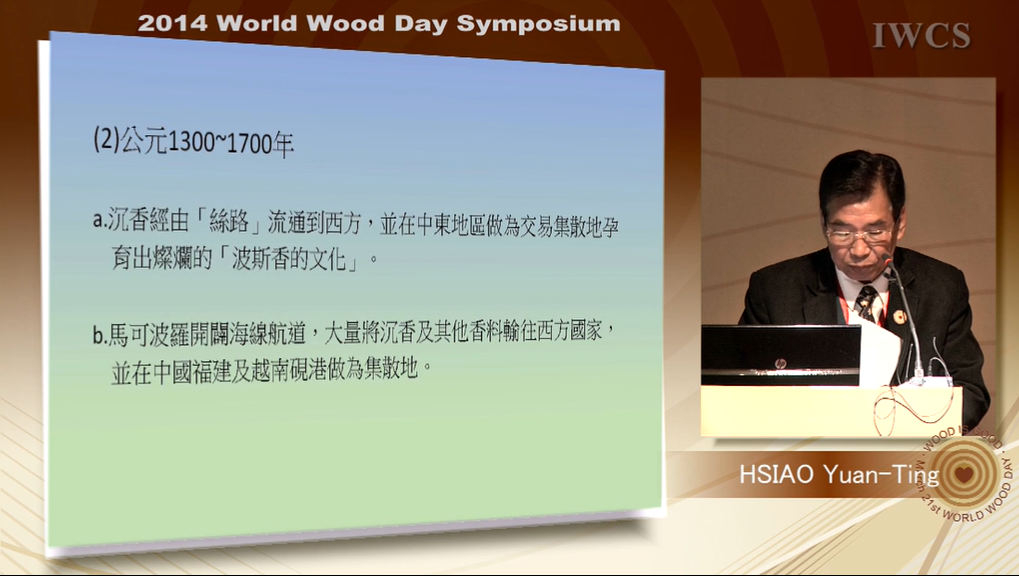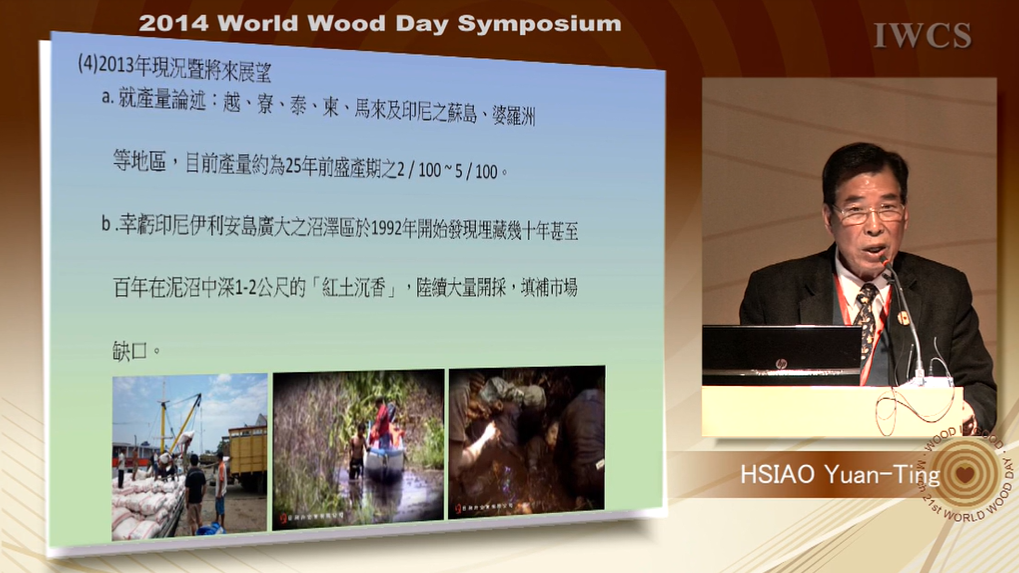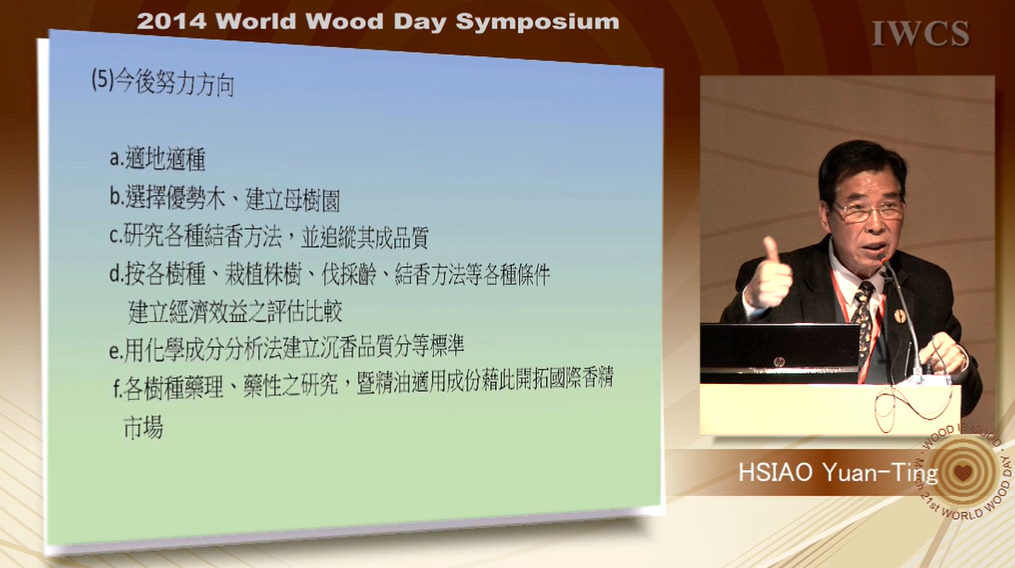会议名称:2014世界木材日研讨会
会议时间:3月21-22日
会议地点:福建·仙游 中国古典工艺博览城
报告人:萧元丁
President, P & I Enterprise Co. Ltd., Taiwan, China
会议时间:3月21-22日
会议地点:福建·仙游 中国古典工艺博览城
报告人:萧元丁
President, P & I Enterprise Co. Ltd., Taiwan, China
Abstract
In Psalm 104:16, agarwood was described as the trees that planted by the Lord. By the 1300s, the Vietnamese book Career of Medical Science recorded that 2300 years ago people already knew how to apply agarwood products into medical treatment and disease prevention. The trees thus were regarded as the best tributes. During the Tang and Song dynasties, Hainan Island planted the best-quality agarwood, which thus resulted in high demand of it in the market. Ever since that time, artificial afforestation and the technology of forming agarwood products have appeared in textual records. Moreover, Malaysia was known for its exportation of agarwood to China.
Between the1300s-1700s, agarwood was circulated to the West via the Silk Road. The areas of the Middle East served as a distribution centre and therefore nurtured a glorious "culture of Persian incense." Starting from Marco Polo's exploration of trading course of the voyage, distributed in the ports of Fujian province and Da Nang of Vietnam, a great number of agarwood was exported to the Western countries. However, the over flow of agarwood into the West had almost wiped out the productions that were originated from India, Nepal, Bengal, Yunnan province, Guangdong and Guangxi provinces, Malaysia, Indonesia, and Indochina. Of those places of origins, after experiencing the ecological restoration for 250 years, Indonesia restarted the exportation fifty years ago. Whereas the countries in the Middle East and Taiwan had become prosperous in economy, the demand of agarwood had extremely increased during 1970-1995. The trees, again, were deforested shortly in forty years. Due to the changing appearance of forests and convenient transportation to forest land, the Convention on International Trade in Endangered Species of Wild Flora and Fauna listed agarwood under the category of critically endangered wood in 1995.
In the past year, the world's output of agarwood was about equivalent to the amount of 2-5 percent of peak harvest time that produced 25 years ago. Fortunately, the recently-excavated agarwood in red soil from the swamp areas of New Guinea, Indonesia, has made up a deficiency of the agarwood in market. Statistics of the same year indicated that these swamp areas could harvest 1500 tons of agarwood trees, occupying more than sixty-five percent of the world's total output (not including those for essential oil). It is anticipated that, with decreasing quality, agarwood from these areas will satisfy the market in ten years. In addition, the artificial afforestation in the past thirty years turned out to be able to provide small amount of agarwood products into market. We expect that this type of products will grow to be popular 20 years later.
Speaker Biography
Mr. HSIAO Yuan-Ting萧元丁
President, P & I Enterprise Co. Ltd., Taiwan
Mr. HSIAO worked at the Council of Agriculture Executive Yuan, Forestry Bureau, Taiwan from 1966 through 1974. During his service period at the Bureau, he passed both the Civil Service 1st-Level Senior Examination and the Examination of Forestry Technician in 1971. After the years of working for the government, he devoted himself to forest exploitation two years in Indonesia starting from 1974. Until the present, he has engaged in agarwood and sandalwood industry since 1976, which has brought him the invaluable travel experience in all the countries where he could explore the ecology of agarwood and sandalwood. His practical profession earned him the Award of Outstanding Enterprise Manager in 1999. In 2010, the speaker demonstrated his entire specialized repository into the book "Agarwood--Mysterious Substance of Energy" in Taiwan. Three years later, Sanjin Publisher received authorization to release it into China's publication market. Furthermore, he was invited to deliver talks on agarwood related topics in the Convention on International Trade in Endangered Species of Wild Flora and Fauna in 2011 and the International Conference of International Wood Culture Society in the following year. In 2013, he was selected as one of the best ten lecturers by The Industrial Technology Research Institute. He is a lecturer of agarwood workshops at the Institute.
In Psalm 104:16, agarwood was described as the trees that planted by the Lord. By the 1300s, the Vietnamese book Career of Medical Science recorded that 2300 years ago people already knew how to apply agarwood products into medical treatment and disease prevention. The trees thus were regarded as the best tributes. During the Tang and Song dynasties, Hainan Island planted the best-quality agarwood, which thus resulted in high demand of it in the market. Ever since that time, artificial afforestation and the technology of forming agarwood products have appeared in textual records. Moreover, Malaysia was known for its exportation of agarwood to China.
Between the1300s-1700s, agarwood was circulated to the West via the Silk Road. The areas of the Middle East served as a distribution centre and therefore nurtured a glorious "culture of Persian incense." Starting from Marco Polo's exploration of trading course of the voyage, distributed in the ports of Fujian province and Da Nang of Vietnam, a great number of agarwood was exported to the Western countries. However, the over flow of agarwood into the West had almost wiped out the productions that were originated from India, Nepal, Bengal, Yunnan province, Guangdong and Guangxi provinces, Malaysia, Indonesia, and Indochina. Of those places of origins, after experiencing the ecological restoration for 250 years, Indonesia restarted the exportation fifty years ago. Whereas the countries in the Middle East and Taiwan had become prosperous in economy, the demand of agarwood had extremely increased during 1970-1995. The trees, again, were deforested shortly in forty years. Due to the changing appearance of forests and convenient transportation to forest land, the Convention on International Trade in Endangered Species of Wild Flora and Fauna listed agarwood under the category of critically endangered wood in 1995.
In the past year, the world's output of agarwood was about equivalent to the amount of 2-5 percent of peak harvest time that produced 25 years ago. Fortunately, the recently-excavated agarwood in red soil from the swamp areas of New Guinea, Indonesia, has made up a deficiency of the agarwood in market. Statistics of the same year indicated that these swamp areas could harvest 1500 tons of agarwood trees, occupying more than sixty-five percent of the world's total output (not including those for essential oil). It is anticipated that, with decreasing quality, agarwood from these areas will satisfy the market in ten years. In addition, the artificial afforestation in the past thirty years turned out to be able to provide small amount of agarwood products into market. We expect that this type of products will grow to be popular 20 years later.
Speaker Biography
Mr. HSIAO Yuan-Ting萧元丁
President, P & I Enterprise Co. Ltd., Taiwan
Mr. HSIAO worked at the Council of Agriculture Executive Yuan, Forestry Bureau, Taiwan from 1966 through 1974. During his service period at the Bureau, he passed both the Civil Service 1st-Level Senior Examination and the Examination of Forestry Technician in 1971. After the years of working for the government, he devoted himself to forest exploitation two years in Indonesia starting from 1974. Until the present, he has engaged in agarwood and sandalwood industry since 1976, which has brought him the invaluable travel experience in all the countries where he could explore the ecology of agarwood and sandalwood. His practical profession earned him the Award of Outstanding Enterprise Manager in 1999. In 2010, the speaker demonstrated his entire specialized repository into the book "Agarwood--Mysterious Substance of Energy" in Taiwan. Three years later, Sanjin Publisher received authorization to release it into China's publication market. Furthermore, he was invited to deliver talks on agarwood related topics in the Convention on International Trade in Endangered Species of Wild Flora and Fauna in 2011 and the International Conference of International Wood Culture Society in the following year. In 2013, he was selected as one of the best ten lecturers by The Industrial Technology Research Institute. He is a lecturer of agarwood workshops at the Institute.
责任编辑:iwcs25Z/H


 3,955
3,955